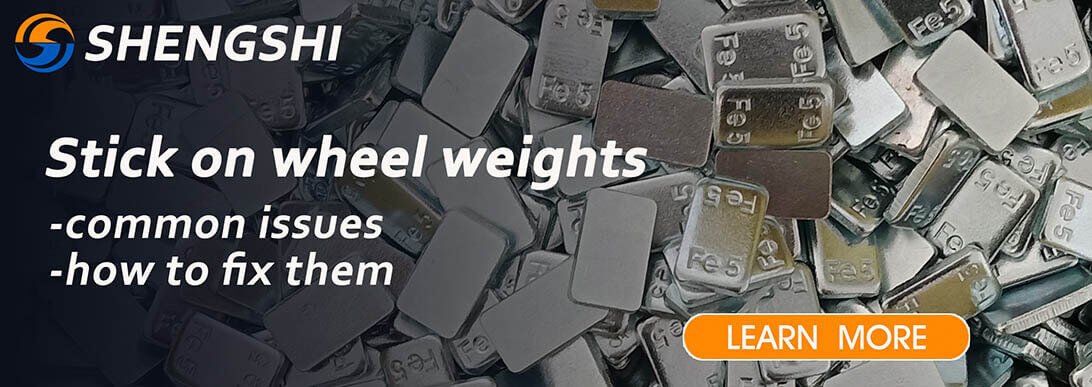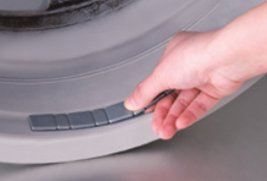Stick on wheel weights–common issues and how to fix them
Introduction
Stick on wheel weights are a commonly used accessory in wheel balance adjustment. It is usually made of metal material with strong adhesive on one side.
During vehicle operation, due to manufacturing deviations or uneven wear of tires and wheels, the wheels may experience uneven mass distribution. Sticky tire weights can accurately increase the weight at specific positions, thereby maintaining balance of the wheels during high-speed rotation.
Stickon wheel weights are easy to install and can adapt to wheels of different shapes and materials without causing damage to the wheels. They help reduce shaking and noise during vehicle operation, improve driving experience and tire lifespan.
Why use sticky tire weights?-Common Wheel Balancing Problems
The use of Sticky tire weights is mainly to solve common wheel balance problems for the following reasons:
1.Wheel manufacturing deviation
During the production process of tires and wheels, it is difficult to achieve completely uniform mass distribution, and there may be slight differences.
For example, the rubber thickness of a certain part of the tire is inconsistent, and the material distribution of the wheel is uneven.
2.Uneven tire wear
After long-term use, different parts of the tire wear to different degrees, resulting in changes in mass distribution.
This is common in situations where the vehicle is often driven on specific road conditions or the four-wheel alignment of the vehicle is inaccurate.
3. Wheel damage
Such as collisions, scratches, etc. may cause local deformation of the wheel, affecting its mass distribution.
4.Replacement of tires or wheels
The newly installed parts may differ from the original ones in mass distribution.
These wheel balance problems will bring many adverse effects, such as:
1.Vehicle shaking
Especially when driving at high speeds, the steering wheel and body will shake significantly, affecting driving comfort and handling.
2.Abnormal tire wear
Unbalanced wheels will cause excessive force on certain parts of the tire, accelerate wear, and shorten the service life of the tire.
3.Damage to the suspension system
Long-term imbalance will increase the burden on the suspension system and cause premature damage to components.
Therefore, in order to ensure wheel balance and reduce the occurrence of the above problems, it is necessary to use sticky wheel weight for weight adjustment.
How Adhesive Wheel Weights Solve Balancing Issues
1.Improve driving comfort
Effectively eliminate vehicle shaking caused by wheel imbalance, so that drivers and passengers can feel more stable and comfortable during driving.
For example, on the highway, balanced wheels can reduce fatigue caused by shaking.
2.Extend tire life
Ensure that the tires are evenly stressed, avoid local excessive wear, reduce the frequency of tire replacement, and save costs for car owners.
For vehicles that often travel long distances, balanced wheels can make tires wear more evenly.
3.Protect vehicle components
Reduce the additional pressure on the suspension system, steering system, etc. caused by wheel imbalance, and reduce the occurrence of failures.
For example, reduce abnormal wear of suspension springs and shock absorbers.
4.Improve fuel economy
Wheel balance can reduce driving resistance and make the engine work more efficiently, thereby saving fuel.
5.Enhance driving safety
Avoid unstable control caused by wheel shaking, especially during emergency braking and steering, to ensure driving safety.
6.Adapt to new technology needs
With the development of intelligence and electrification of modern cars, the requirements for wheel balance are higher, and sticking balance blocks can be adjusted accurately.
7.Compatibility with Different Wheel Types
The stick-on wheel balance weights are compatible with most common wheel types, such as carbon fiber wheels, steel wheels, and aluminum alloy wheels.
Common Problems with Installing Sticky Tire Weights
Poor Adhesion
- Causes
The surface of the wheel is dirty
Poor bonding quality
Improper installation
- Solutions
Thoroughly clean the surface of the wheels
Use high-quality adhesive products
Follow the correct installation procedur
Weights Falling Off
- Causes
Extreme temperature changes
Drive at high speed
Improper use of wheel weights
- Solutions
Use high-temperature resistant adhesive
Ensure that the wheel weight is placed correctly and securely fixed
Regularly inspect and replace loose wheel weight
Unbalanced Wheels
- Causes
The size or position of the Sticky tire weights is incorrect
The Sticky tire weightsmoves or falls off
- Solutions
Use the appropriate wheel weight size for your wheels
Regularly rebalance the wheels
Correctly fix the wheel weight to prevent movement
How to Properly Install Sticky Tire Weights
- Conduct balance checks on the balancing machine;
- Determine the type of wheel rim;
- Determine whether you want to use clamp or adhesive;
- Choose the appropriate weight and conduct trial assembly to ensure accuracy;
- If installing a clamp type counterweight, please use a soft headed hammer to ensure that there are no scratches during installation; If installing Sticky tire weights, please use a soft headed hammer to ensure that there are no scratches during installation; If installing Sticky tire weights, please clean the wheels correctly in advance;
- Rotate the components again to ensure proper balance is achieved.
Additional Resources
The importance of regular maintenance:
1.Ensuring driving safety: promptly identifying and resolving issues with the balance block, avoiding vehicle shaking and unstable handling caused by wheel imbalance, and reducing the risk of accidents.
2.Extend the lifespan of tires and vehicle components: Balanced wheels can evenly wear tires, reduce the burden on suspension, steering, and other components, and extend their service life.
3.Improve fuel efficiency: reduce driving resistance and lower fuel consumption.
Improve fuel efficiency: reduce driving resistance and lower fuel consumption.FAQ
What are stick on tire weights made from?
Weight materials: Common weight materials include metals such as lead, zinc, and iron.
Adhesive tape: blue tape, Red tape Paper tape, Norton tape,3Mtape, Lohmann tape, White tape.
Protective layer: Colors include red, blue, white, etc
Are adhesive wheel weights better?
Yes, it can be compatible with both steel wheels and aluminum alloy wheels, with simple operation and easy installation.
How do you remove sticky residue from wheel weights?
Cleaning agents or tape grinding wheels can be used
Do adhesive wheel weights fall off?
Yes, when exposed to extreme environments such as high temperature, low temperature, and humidity for a long time, the performance of the tape may decrease. There is also a strong impact: if the vehicle encounters severe bumps or collisions while driving, it may cause the adhesive wheel weights to fall off






